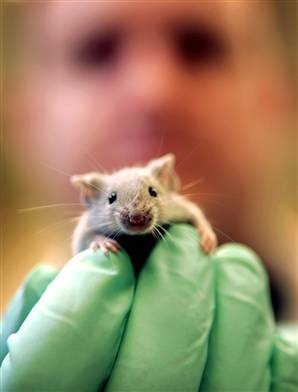The link between retinyl palmitate, sunlight and the increased risk of cancer has been confirmed by the National Toxicology Program. The NTP’s report comes after a year long study on mice.
Whether retinyl palmitate in sunscreens is carcinogenic is a controversial issue. The FDA has been reviewing data from several studies on a potential link between retinyl palmitate and cancer risks since July 2009. The issue has been hotly debated between the Environmental Working Group (EWG) and the cosmetics industry. Because of this I’m going to quote the NTP verbatim even though its
report, “
On The Photococarcinogenesis Study of Retinoic Acid and Retinyl Palmitate” which was peer reviewed yesterday (1/26/11), is marked as “not for attribution”.
The study:
"Groups of 36 male and 36 female Crl: SKH-1 (hr–/hr–) hairless mice were irradiated 5 days per week (Monday through Friday) in the morning for 40 weeks with SSL at levels of 0.00, 6.85, or 13.70 mJ•CIE/cm 2 that were emitted from glass-filtered 6.5 kW xenon arc lamps. The mice received topical applications of control cream or creams containing 0.001% (w/w) RA or 0.1%, 0.5%, 1.0%, or 2.0% RP to the dorsal skin region in the afternoon of the same days of irradiance exposures."
The conclusions:
Retinoic Acid - Compared to the control cream, RA enhanced the photocarcinogenic activity of SSL and UVB in SKH-1 mice based upon earlier onsets and increased multiplicities of in-life skin lesions.
Retinyl Palmitate - Compared to the control cream, RP enhanced the photocarcinogenicity activity of SSL and UVB in SKH-1 mice based upon earlier onsets and increased multiplicities of in-life skin lesions and increased incidences and multiplicities of squamous cell neoplasm’s.
This conclusion is similar to results of earlier studies on mice. However, other research (not always independent, it has to be said) contradicts those finding. For more, see our post on
retinyl palmitate and skin safety.
The EWG issued a
statement yesterday saying that it "recommends manufacturers of cosmetics, sunscreens and other personal care products remove retinyl palmitate from all products to be used on sun-exposed skin and that consumers avoid buying products that contain this chemical."





May 14, 2012
by stephen
I work as a Park Ranger and so skin cancer is a concern...as it is with truckers...UV penetrates auto glass...my first skin pre cancerous lesion was on my left ear. That said if the sunscreens were really doing good work than why are skin cancers increasing by 2% per year. The rp ingredient is particularly disturbing in that it increases mitosis and probably does not differentiate between good and bad cells. You would think that the NIH would be funded for studies on this but...considering the businesses involved in profiting on both the front end (sunscreen mfgs and pharmacutical companies) and on the back end...(cancer doctors and dermotologists) all I can say is watch the exposure, increase Vit. D and ALA orally during the sun season and cover up. I wear long sleeve shirts on patrol...and a hat
February 11, 2012
by Janet Lamar
Marta:
Please note to your readers that this isn't the definitive study on RP. It is one study. I could cite other studies that draw the opposite conclusions:
“There is no conclusive evidence to indicate the combination of retinyl palmitate and UV radiation causes increased rates of skin cancer.”
"It is important to note that the mice in the NTP study are highly susceptible to the effects of UV radiation and can develop skin cancer or other skin abnormalities within weeks of UV exposure, even in the absence of retinyl palmitate," said Dr. Wang. "That is why extreme caution is needed when extrapolating these animal study results to humans."
Additionally, readers such as myself have issues with the EWG.
In terms of sunscreen protection, I think we should all look beyond protection from a mere cream or lotion to a more comprehensive sun protection plan which includes staying out of direct sunlight in the powerful hours and wearing protective clothing.
November 2, 2011
by Marc
Actually, according to that experiment, they didn't put the vitamin A cream on the mice until AFTER they fried them under the lamp. So apparently skin cells don't like vitamin A very much, and especially not when they're stressed.
Retinoic acid does the same thing but multiplied, and has other horrible, toxic effects, too.
Guess vitamin A is coming off my ingredients list now :|.
June 25, 2011
by Red Alert? : Retinyl Palmitate | Hope in a Blog
[...] more information, head over to Truth In Aging. [...]
March 3, 2011
by marta
Hi Steffie, the real danger from retinyl palmitate comes when it degrades in sunlight. So theoretically it is safer to use it at night. All retinols can dry the skin and some people find them irritating.